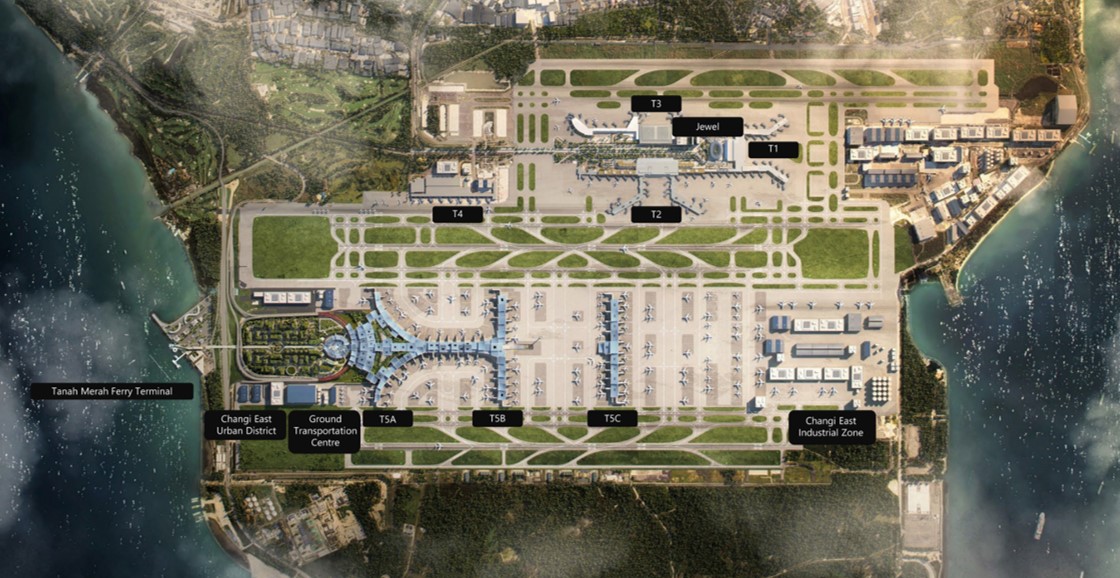Research, editing : Gan Yung Chyan, KUCINTA SETIA
News on aviation management, U.S., disease control
News (1) to (11) / Source : Changi Airport Group / Images : Gan Yung Chyan
News (1)
Changi Airport Terminal
5 to be built resilient and sustainable
First announced in 2013, Changi Airport’s Terminal 5 (T5) is a project undertaken by the Ministry of Transport (MOT), the Civil Aviation Authority of Singapore (CAAS) and Changi Airport Group (CAG).
Due to the covid pandemic, the T5 project was paused for two
years. During this time, MOT, CAAS and CAG re-assessed the trajectory of
aviation growth, and reviewed T5’s design to make it more modular, and to
enhance its resilience and sustainability.
Following Singapore’s reopening, air travel demand has recovered
strongly at Changi Airport. Beyond the immediate recovery, the long-term
prospects for aviation also remain bright. In particular, the International Air
Transport Association has projected that the Asia-Pacific would be the
fastest-growing region for air travel over the next two decades.
To secure Singapore’s capacity to ride on the long-term growth
of aviation, work on the T5 project has resumed. CAG is re-mobilising the
design and engineering consultants to refine the T5 design. Construction is
expected to commence in about two years, for T5 to be operational around the
mid-2030s.
T5 will be located within the 1,080-hectare Changi East development that is almost as big as the land area of today’s Changi Airport. It will be able to handle about 50 million passengers per year, and will be designed with the flexibility to be built in two phases, in line with traffic growth.
This additional capacity from T5 will strengthen Changi
Airport’s position as a premier air hub for the region and beyond, and will ensure
that future generations of Singaporeans can continue to benefit from Changi’s
global connectivity.
News (2)
Changi Airport T5 can handle future pandemics more nimbly
Drawing on lessons learnt from the covid pandemic, T5 will be designed with the flexibility to operate as smaller sub-terminals when needed, with space that could be converted for use during contingencies, such as for testing operations or the segregation of high-risk passengers.
Specialised provisions to reduce the transmission of diseases
will also be deployed in T5. This includes contactless systems at passenger
touchpoints, as well as enhanced ventilation systems that can be activated
during a pandemic to increase the use of fresh air and minimise the mixing of
air.
News (3)
T5 will be green and sustainable
T5 will be a Green Mark Platinum Super Low Energy Building as
certified by the Building and Construction Authority.
To reduce the carbon footprint of T5, solar panels, smart
building management systems, as well as district cooling combined with thermal
energy storage, will be deployed in the terminal building.
T5 will also be ready for viable alternative fuels including the
use of Sustainable Aviation Fuel, and for the provision of fixed ground power
and cooling for aircraft parked at the gates.
News (4)
Designed for the deployment of automation at scale
T5 will leverage technology to automate and digitalise airport
operations, to enhance the passenger experience and increase manpower
productivity. For example, T5 could see the deployment of autonomous vehicles
to support baggage and cargo transport on the airside, as well as robotics for
baggage handling. The terminal will be designed to accommodate and facilitate
deployment of such technology at scale.
These efforts will provide Singaporean enterprises with an
opportunity to build capabilities in new, emerging areas such as robotics and
artificial intelligence, and ultimately create quality jobs for Singaporeans
within the airport ecosystem.
News (5)
T5 to connect all Singaporeans
T5 will reinforce Changi Airport as a national icon, and ensure
that it will continue to be a place of shared experiences across generations of
Singaporeans. It will be another terminal where Singaporeans welcome and send
off their loved ones, and forge precious memories with their friends and families.
News (6)
T5 of proximity to Aviation Park
News (7)
CEUD will be constructed next to T5 and Changi Beach Park
Located at the doorstep of T5, which is along the road bordering
Changi Beach Park, the Changi East Urban District (CEUD) will create new spaces
for Singaporeans to connect, work and play. Master-planning for the development
of the CEUD will be done in consultation with the Ministry of National
Development, the Urban Redevelopment Authority and other agencies.
News (8)
Changi East outlined
Spanning a massive 1,080
hectares, the Changi East development will provide future capacity for Changi
Airport. The development will serve to secure Singapore’s air hub status and
ensure its continued competitiveness and relevance.
 Image credit : Changi Airport Group
Image credit : Changi Airport GroupAs Changi Airport’s
largest expansion project to date, the development includes Changi Airport’s
fifth terminal, Terminal 5 (T5), a three-runway system, the construction of
tunnels and other underground systems, landside and aviation support facilities
and the Changi East Industrial Zone.
The total area of works at Changi East is equivalent to 667 football
fields
The total pavement length in the development is
equivalent to Singapore’s Pan Island Expressway.
The total length of on-site drainage is equivalent to the
length of 435 MRT trains.
News (8)
T5 will be linked to Terminals 1 to 4
T5 will
be linked to the other terminals at Changi Airport, allowing the expanded Changi
Airport to be operated as a single, integrated airport for ease of transfer
between different terminals with airfield operational efficiency. New
facilities, such as navigation aids, airfield lighting systems and a fire
station will also be constructed.
News
(9)
The
third runway will be operational for commercial flights by the mid-2020s
The existing third runway, previously used
only by the military, has been extended from 2.75km to 4km to handle larger
passenger aircraft, and converted for joint military-civilian use.
Under the three-runway programme, almost
40km of new taxiways will also be built to connect the runway with the rest of
Changi Airport. This three-runway system is scheduled for operationalisation by
the mid-2020s.
News (10)
Changi Airport to expand Changi Airfreight
Centre
Changi Airport’s cargo facilities, currently located at the Changi Airfreight Centre, will be expanded to the Changi East Industrial Zone (CEIZ) as part of the Changi East Development.
The zone will be developed for airfreight,
air express and Maintenance, Repair and Operations (MRO) activities. Together
with the remodelled Changi Airfreight Centre, Changi’s handling capabilities
will increase from 3 million tonnes per annum today, to 5.4 million tonnes per
annum in its end-state, when the project is completed.
News (11)
Changi Airport aims to be a smart cargo hub
The future expanded air cargo hub of Changi Airport will be smarter, more connected and more efficient. The use of data and technology with a focus on automation will reduce processing time, and improve productivity and cargo visibility.
Strategic infrastructure planning will
ensure greater operational efficiency, with dedicated lanes for autonomous
guided vehicles. Direct access to freighter aircraft from cargo and express
terminals will also speed up cargo flows.
With environmental and workplace
sustainability in mind, the new air cargo hub will feature eco-friendly
handling equipment, convenient amenities and a land transport network for
staff.
Timeline:
|
2013 |
Singaporean Prime Minister Lee Hsien Loong spoke about the
plans for T5 and Changi East in his National Day Rally speech. Shortly after,
the Changi 2036 Steering Committee, which was established to develop a
holistic long-term plan for the expansion of Changi Airport, announced its
recommendations to construct T5 and implement a three-runway system at
Changi. |
|
2014 |
Land preparation works
for Changi East and planning for T5 began in 2014, including functional
design studies and concept development for the terminal. |
|
2018 |
CAG announced the
appointment of the Master Building Consultants (MBC) in 2018, to provide
architectural design and engineering consultancy services for the development
of T5. The Master Civil Consultants (MCC) were also appointed, to provide
consultancy services for the design of infrastructure at the landside and
airside areas outside of the T5 buildings. |
|
2020 |
A two-year pause of the
T5 project was announced in 2020, due to the Covid-19 pandemic. The aim was
to assess the impact of Covid-19 on aviation growth, learn from the pandemic
experience, and review T5’s design to meet the needs of post-pandemic travel. |
|
2022 |
The resumption of work
on the T5 project was announced in 2022. MOT, CAAS and CAG had taken the
opportunity of the two-year pause to comprehensively review the T5 design to
make it more modular, resilient and sustainable. Construction of T5 will
commence in about two years for T5 to meet the anticipated demand for air
travel around the mid-2030s. |
News (12)







.JPG)





No comments:
Post a Comment